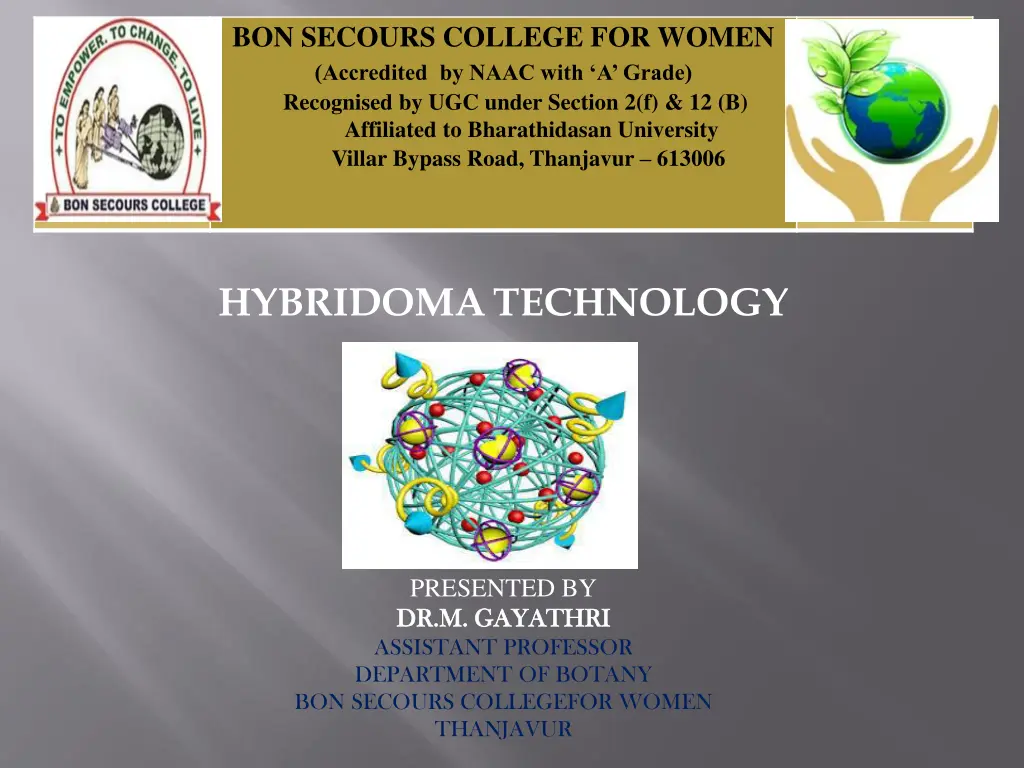
Understanding Hybridoma Technology: A Breakthrough in Antibody Production
Learn about hybridoma technology, a revolutionary method developed in 1975 by scientists Georges Köhler and César Milstein, for producing monoclonal antibodies in large quantities. This technique involves fusing antigen-specific plasma cells with myeloma cells to create hybridomas, which can produce pure antibodies continuously. Explore the process, advantages, and applications of hybridoma technology in the field of biotechnology.
Download Presentation

Please find below an Image/Link to download the presentation.
The content on the website is provided AS IS for your information and personal use only. It may not be sold, licensed, or shared on other websites without obtaining consent from the author. If you encounter any issues during the download, it is possible that the publisher has removed the file from their server.
You are allowed to download the files provided on this website for personal or commercial use, subject to the condition that they are used lawfully. All files are the property of their respective owners.
The content on the website is provided AS IS for your information and personal use only. It may not be sold, licensed, or shared on other websites without obtaining consent from the author.
E N D
Presentation Transcript
BON SECOURS COLLEGE FOR WOMEN (Accredited by NAAC with A Grade) Recognised by UGC under Section 2(f) & 12 (B) Affiliated to Bharathidasan University Villar Bypass Road, Thanjavur 613006 HYBRIDOMA TECHNOLOGY PRESENTED BY DR.M DR.M. GAYATHRI . GAYATHRI ASSISTANT PROFESSOR DEPARTMENT OF BOTANY BON SECOURS COLLEGEFOR WOMEN THANJAVUR
Introduction Methodology Purification of Antibodies Application Conclusion
Hybridomas are cells that have been engineered to produce a desired antibody in large amounts, to produce monoclonal antibodies. Monoclonal antibodies can be produced in specialized cells through a technique now popularly known as hybridoma technology Hybridoma technology was discovered in 1975 by two scientists, Georges Kohler and Cesar Milstein, who jointly with Niels Jerne of Denmark (now working in Germany) were awarded the 1984 Noble prize for physiology and medicine. The term hybridoma was coined by Leonard Herzenberg during his sabbatical in C sar Milstein's laboratory in 1976/1977
A hybridoma, is produced by the injection of a specificantigen into a mouse, procuring the antigen-specific plasma cells (antibody-producing cell) from the mouse's spleen and the subsequent fusion of this cell with a cancerous immune cell called a myeloma cell. Once splenocytes are isolated from the mammal s spleen,the B cells are fused with immortalised myeloma cells. The hybrid cell, which is thus produced, can be clonedto produce many identical daughter clones. These daughter clones then secrete the immune cell product. Since these antibodies come from only one type of cell (the hybridoma cell) they are called monoclonal antibodies. The advantage of this process is that it can combine the qualities of the two different types of cells; the ability togrow continually, and to produce large amounts of pure antibody.
HAT medium (Hypoxanthine Aminopetrin Thymidine) isused for preparation of monoclonal antibodies. Laboratory animals (eg. mice) are first exposed to anantigen to which we are interested in isolating an antibody against. Once splenocytes are isolated from the mammal, the Bcells are fused with immortalized myeloma cells - which lack the HGPRT(hypoxanthine-guanine phosphoribosyl transferase) gene - using polyethylene glycol or the Sendai virus. Fused cells are incubated in the HAT (HypoxanthineAminopetrin Thymidine) medium. Aminopterin in the myeloma cells die, as they cannotproduce nucleotides by the de novo or salvage medium blocks the pathway that allows for nucleotide synthesis. Hence, unfused D cell die. Unfused B cells die as they have a short lifespan. Only the cell-myeloma hybrids survive, since the HGPRTgene coming from the B cells is functional. These cells produce antibodies (a property of B cells) and are immortal (a property of myeloma cells).
The incubated medium is then diluted into multiwell plates to such an extent that each well contains only 1 cell. Then the supernatant in each well can be checked for desired antibody. Since the antibodies in a well are produced by the same B cell, they will be directed towards the same epitope, and are known as monoclonal antibodies Multi-well plates are used initially to grow the hybridomas and after selection, are changed to larger tissue culture flasks. This maintains the well being of the hybridomas and provides enough cells for cryopreservation and supernatant for subsequent investigations.
Monoclonal antibodies may need to be purified before they are used for a variety of purposes. Antibodies can be purified by anyone of the following techniques (I)ion-exchange chromatography; (ii) antigen affinity chromatography. Serum Free Media for Bulk Culture of Hybridoma Cells The use of serum, however, leads to difficulties in purification of antibodies. it is an expensive technology for large scale production of hybridoma cells for industrial production of monoclonal antibodies. In view of these difficulties, serum free media are being increasingly used for culturing hybridoma cells.
Advantages of Serum Free Media in Hybridoma Cell Culture and Preparation of MonoclonalAntibodies 1.Greatly simplified purification of antibodies due to increased 2.Initial purity and absence of contaminating immunoglobulin. 3.Decreased variability of culture medium. 4.Reduced risk of infectious agents. 5.Fewer variables for quality control/quality assurance. 6.Increased control over bioreactor conditions. 7.Potential for increased antibody secretion. 8.Low or no dependence on animals. 9.Cost effective. 10.Overall enhanced efficiency
1.Not all serum free media are applicable to all cell lines. 2.Cells may not grow to as high densities and may be more fragile than cells in serum 3.Media may take longer to prepare
Monoclonal antibodies or specific antibodies, are now an essential tool of much biomedical research and are of great commercial and medical value. (I) Diagnosis (including ELISA test for detection of viruses and imaging), (ii)Immunopurification (iii)Therapy Monoclonal antibodies are used, for instance, to distinguish subsets of B cells and T cells. In diagnosis, pregnancy can be detected by assaying of hormones with monoclonal. Monoclonal antibodies are being used to track cancer antigens and, alone or linked to anticancer agents, to metastases. The monoclonal antibody known as OKT3 is saving organ transplants threatened with rejection, and preventing bone marrow transplants from setting off graft-versus-host disease (immune system series) attack cancer
It is used for the early detection of pregnancy. Detection and treatment of cancer. Diagnosis of leprosy. Treatment of autoimmune diseases. Radiolabelled monoclonal antibodies are used in vivo for detecting or locating tumor antigen. Used for making immunotoxins that inhibit protein synthesis. Eg: ricin, shigella toxin & diphteria toxin.
Hybridoma technology is the valuable for preparing antibody in vitro condition Monoclonal antibodies, as they are known, have opened remarkable new approaches to preventing, diagnosing, and treating disease. It is helpful in various aspects .
www.google.com www.wikipedia.org www.studymafia.org




